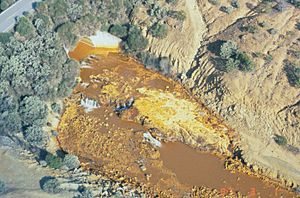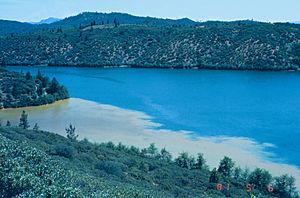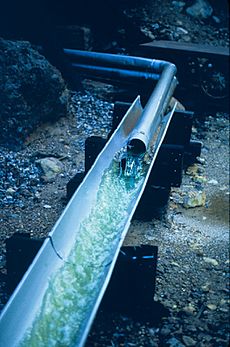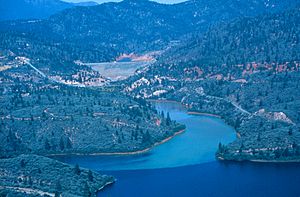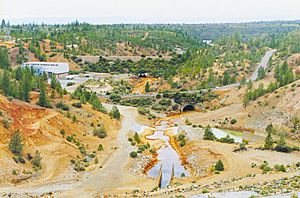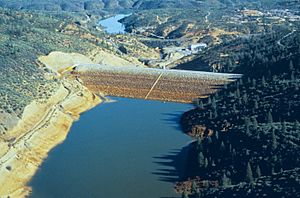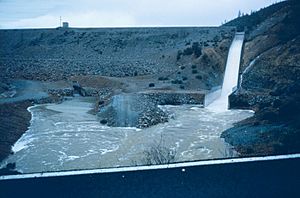Spring Creek Dam facts for kids
Quick facts for kids Spring Creek Dam |
|
|---|---|
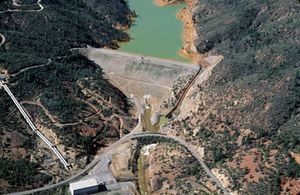 |
|
| Official name | Spring Creek Debris Dam |
| Location | Shasta-Trinity National Forest Shasta County, California |
| Coordinates | 40°37′47″N 122°28′27″W / 40.6298°N 122.4741°W |
| Construction began | 1961 |
| Opening date | 1963 |
| Operator(s) | Bureau of Reclamation |
| Dam and spillways | |
| Impounds | Spring Creek |
| Height | 196 ft (60 m) |
| Length | 1,110 ft (340 m) |
| Spillway type | Uncontrolled concrete overflow |
| Spillway capacity | 5,260 cubic feet per second (149 m3/s) |
| Reservoir | |
| Creates | Spring Creek Reservoir |
| Total capacity | 5,870 acre⋅ft (7,240 dam3) |
| Catchment area | 16 sq mi (41 km2) |
| Power station | |
| Turbines | 2x 90 MW Francis turbines |
| Installed capacity | 150 MW 180 MW (max) |
The Spring Creek Debris Dam is a special kind of dam in Shasta County, California. It was built on Spring Creek, which flows into the Sacramento River. This dam was finished in 1963 and is managed by the U.S. Bureau of Reclamation.
Its main job is to collect very harmful acid mine drainage. This is polluted water that comes from the old Iron Mountain Mine. The dam creates the Spring Creek Reservoir, which is less than 1 mile (1.6 km) long. Spring Creek and South Fork Spring Creek flow into this reservoir. The dam is located just upstream from the city of Keswick, California.
The Spring Creek Dam was built to stop pollution from the Iron Mountain Mine. This mine was heavily polluting Spring Creek and its smaller streams. The polluted water was flowing into the Sacramento River. This river is a major water source for millions of people in California. Even though the area around Spring Creek is small, its water is among the most polluted and acidic in the world.
The dam, along with other cleaning systems, has greatly reduced pollution. It has cut down dry weather pollution by up to 95 percent. However, large, uncontrolled spills from the reservoir still happen sometimes. When these big spills occur, water from Shasta Lake is released. This helps to dilute the acid and make it less harmful.
Contents
Building the Dam: A Story of Pollution and Progress
The Problem: Iron Mountain Mine Pollution
The Iron Mountain Mine was a very active copper mine in California. It operated near Spring Creek from 1879 to the 1960s. The mine dug up iron, silver, gold, copper, and other minerals. People first found iron ore here in 1860. Then, silver was discovered in 1879, and the mine started.
By the late 1800s, the Iron Mountain Mine was blamed for killing many fish in the Sacramento River. Even so, mining continued. By 1928, 600 tons of ore were being dug out every day.
The pollution from Iron Mountain Mine was a huge problem. One expert described it as the "largest and most difficult acid mine drainage problem in the United States." The polluted water killed almost all aquatic life in the creeks around the mine.
Why the Dam Was Needed
When the Shasta Dam (in 1943) and Keswick Dam (in 1950) were built, they changed how the Sacramento River flowed. Before, the river could wash away pollution from the mine. But now, the polluted water from Spring Creek flowed directly into the Keswick Reservoir. This caused dirty mud to build up and turned parts of the water a rusty red color. The water pooling in the reservoir made it very hard to remove the pollution.
From 1955 to 1962, the mine used open-pit mining. At its worst, the mine released huge amounts of iron, copper, and zinc into the creek every day. The water became so polluted that a special dam was needed to hold it back. This dam was the Spring Creek Dam.
Construction of the Spring Creek Dam began in 1961. The company Gibbons and Reed won the contract. Work started in July 1961, and the dam was officially dedicated in September 1961. Building the dam itself began in October 1961. The dam's base even used some acidic mud dug from Spring Creek.
In 1962, worker strikes caused delays. Work stopped for a while in May. When it restarted in June, they ran out of some building materials. So, they used other materials to finish the dam's core.
Eventually, the Iron Mountain Mine closed. But the pollution continued. In 1983, the Iron Mountain Mine was added to the National Priorities List. This list includes the most polluted sites in the U.S. The water inside the Iron Mountain Mine is known to be the most acidic natural water on Earth. Some samples from the early 1990s had a pH value of -3.6. This is about 100 times more acidic than battery acid! However, the average pH of water entering the Spring Creek Reservoir is 4.12.
Making the Dam Bigger
The Spring Creek Dam was later found to be too small for the amount of water flowing into Spring Creek. Both natural water and acid mine drainage caused frequent, uncontrolled spills from the dam. These spills contained very harmful chemicals from the acid mine drainage.
To fix this, several ideas were considered:
- Make the dam much bigger: This would have created a reservoir three times its original size. But it would have cost about $75 million, so it was not built.
- Cover parts of the mine: This idea was considered because the ore body was not very deep. But the mountain had many cracks, making this plan difficult.
- Build dams upstream: This plan involved building several dams upstream to reduce the amount of water flowing into the main dam by 40 percent. This plan was actually put into action. It meant the main dam did not need to be enlarged.
- Remove waste rock: Rocks dug from the mine were moved and stored in a special, packed area. This has helped lower the acid level in Boulder Creek, another stream that flows into Spring Creek.
Recent Challenges and Solutions
In 1985, engineers found that water was leaking into the dam's foundations. This raised concerns that the dam could collapse. In the 1990s, there was a big debate about the uncontrolled spills of mine toxins from the dam.
In March 1992, a large, unexpected spill of acidic water rushed from the dam. It heavily polluted the Keswick Reservoir and threatened the water supply for Redding, California. Even though the area was in a drought, 77,000 acre-feet (95,000,000 m³) of water were released from Shasta Lake to dilute the pollution. This lost water was badly needed by farmers and cost about $18 million.
To solve this, a water treatment plant was built near the Iron Mountain Mine. It uses lime to balance the pH of the acid mine drainage. Water from Slickrock Creek is also sent to this plant for treatment. Overall, more than 95 percent of the toxins in the water are removed. The treatment process uses about 8.5 miles (13.7 km) of special acid-resistant pipes. These pipes cost over $1 million per mile! Most water directly from the mine has a pH level close to 1. However, natural water flow and water from nearby Clear Creek help to dilute the acidic water before it is treated.
How Spring Creek Flows
Spring Creek is a 9-mile (14 km) long stream that flows southeast. It is a tributary of the Sacramento River and collects water from about 16 square miles (41 km²) of land. The creek starts in the Klamath Mountains and flows southeast. Then, it turns south and sharply west into the Spring Creek Reservoir. From the reservoir, it flows west until it empties into an arm of the Keswick Reservoir.
The creek itself does not run directly by the mine. The acid mine drainage that pollutes Spring Creek comes from two smaller streams: Boulder Creek and Slickrock Creek. Boulder Creek flows from the north side of Iron Mountain Mine to Spring Creek. Slickrock Creek drains the south side of the mine and also flows into Spring Creek. South Fork Spring Creek is another small stream that flows into the Spring Creek Reservoir. But since it is far from the mine, it does not get acid mine drainage.
The amount of water flowing into and out of the reservoir changes a lot. It can range from 0 cubic feet (0 m³) per second to about 225 cubic feet (6.4 m³) per second in just a 10-day period.
Dam Size and How It Works
The Spring Creek Dam is 196 feet (60 m) high. It is 1,110 feet (338 m) long across its top and 1,040 feet (317 m) thick at its base. The top of the dam is 816 feet (249 m) above sea level. When the reservoir is full, the water level is 795 feet (242 m) above sea level. At full capacity, the reservoir holds 5,870 acre-feet (7,240,000 m³) of water. This water can be about 184 feet (56 m) deep.
The dam has a spillway that runs over its top on the left side of the canyon. This spillway is 25 feet (7.6 m) wide. It can handle a water flow of 5,260 cubic feet (149 m³) per second. The dam also has outlet works at its base. These can release 660 cubic feet (19 m³) of water per second. The Spring Creek Powerplant, located below the dam, can generate up to 180,000 kilowatts of electricity.
Spring Creek Powerplant
The Spring Creek Powerplant is at the bottom of the Spring Creek Dam. It actually gets its water from Whiskeytown Lake. This lake is formed by Whiskeytown Dam on Clear Creek, which is downstream from Spring Creek along the Sacramento River. Both streams flow east into the river.
The power plant started working in 1964. It first had a capacity of 150,000 kW, which was later increased to 180,000 kW. This plant is a peaking power plant. This means it generates extra power when it's most needed. It has two generators that produce electricity for the dam's operations and send extra power to the local power grid. Water from Whiskeytown Lake travels through the Spring Creek Tunnel. This tunnel is about 2.4 miles (3.9 km) long and 18.5 feet (5.6 m) wide.
The U.S. Bureau of Reclamation explains how the power plant works:
The power plant has two generators, each producing 100,000 kVA. They use Francis turbines. Water from Whiskeytown Reservoir travels through the Spring Creek power conduit. This conduit is about 4.8 kilometers (3 miles) long and varies in width. It includes two tunnels and a siphon. Two large pipes then carry the water to the power plant.
Spring Creek Reservoir
The Spring Creek Reservoir is the artificial lake behind the dam. It is mainly used to control floods. It is rarely filled to its full capacity of 5,870 acre-feet (7,240,000 m³). During the dry season, water from Spring Creek collects in a small, still pond behind the dam. This causes polluted mud and acid mine waste to settle in the reservoir.
When there is enough water flowing from the Shasta Dam (upstream on the Sacramento River) to wash away polluted water, the water in the reservoir is released. It flows through the dam's outlet into the Keswick Reservoir and then into the Sacramento River.
However, the reservoir was found to be too small for the amount of water in the area. A single heavy storm can fill it completely. This often leads to uncontrolled spills of polluted water into the Sacramento River through the dam's spillway, which has no gates. These sudden releases of pollution have caused many fish kills. A major one happened in 1969. Because of this ongoing acid pollution, most large fish now lay their eggs downstream of the Red Bluff Diversion Dam, near Red Bluff, California.
Spillway and Outlet Works
The Spring Creek Dam can release up to 5,920 cubic feet (168 m³) of water per second from the Spring Creek Reservoir. This happens through its crest spillway and outlet works. The spillway starts on the left side of the dam at an elevation of 795 feet (242 m). It drops about 184 feet (56 m) down the dam's face into a special pool. From there, the water flows into Spring Creek and then into the Sacramento River. It is about 25 feet (7.6 m) wide and can carry 5,260 cubic feet (149 m³) per second.
The outlet works tunnel through the dam from a much lower elevation than the spillway. The water exits through a culvert at the base of the dam. This design is common for storm drains but rare for dams. The outlet works can release a maximum of 660 cubic feet (19 m³) per second.


